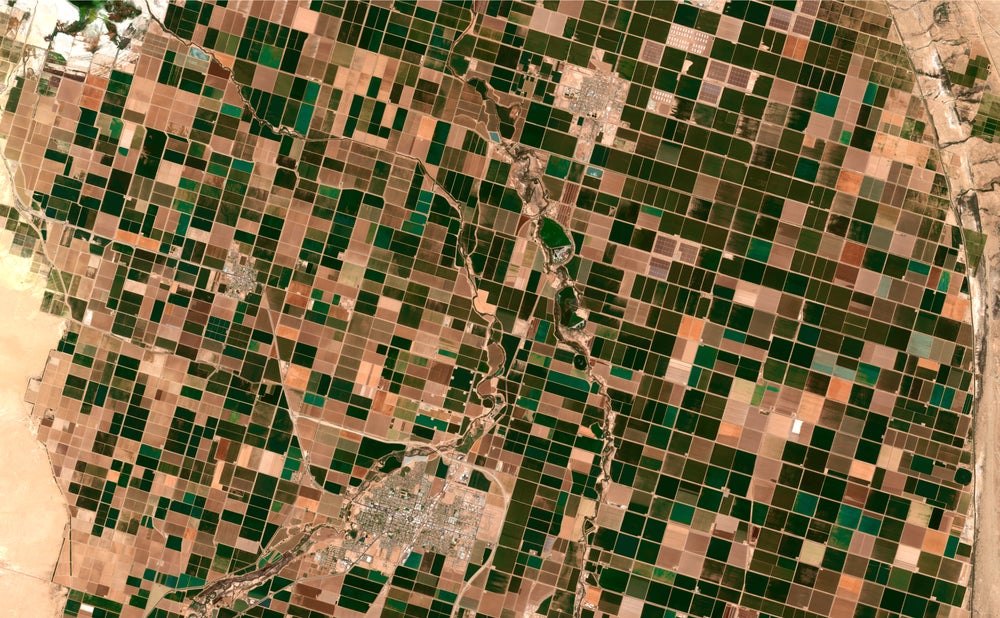We live in a world driven by data, but one sector you may not have heard referenced too much in terms of data is the Earth observation data industry.
It is an industry that has operated ‘under the radar’ but the reality is that Earth observation offers a trillion-dollar opportunity, according to the World Economic Forum.
A study produced by the Forum, together with consultancy Deloitte, called, ‘Amplifying the Global Value of Earth Observation’, puts the potential value of Earth observation data at $700bn in 2030 with a cumulative $3.8trn contribution to global gross domestic product between 2023 and 2030. Perhaps more importantly, in the wider scheme of things, Earth observation can inform interventions that stand to reduce greenhouse gas emissions by more than two billion tonnes (Gt) of CO₂ equivalent annually.
The study says that six industries will be responsible for 94% of Earth observation’s total possible value by 2030. The six industries include agriculture, where uses of Earth observation data are wide-ranging and span cropping, fisheries, livestock, and timber; electricity and utilities, where early adopters of observation data have gained an information advantage that extends from site selection to management of transmission infrastructure; and government, public and emergency services, where Earth observation by satellites was initially government-led and where applications for public and emergency services are generally robust.
Better data means more accurate modelling of hazards and near real-time monitoring of structures, land, and vegetation, which in turn means better disaster preparedness and response. The other three industries are insurance and financial services; mining, oil, and gas; and supply chain and transportation.
Despite the benefits, Earth observation data has a few hurdles to overcome
The Forum argues that the prospect of adding a cumulative $3.8trn to the global economy from 2023 to 2030 and reducing emissions by 2Gt per year is a compelling case for increasing the uptake of Earth observation.
How well do you really know your competitors?
Access the most comprehensive Company Profiles on the market, powered by GlobalData. Save hours of research. Gain competitive edge.

Thank you!
Your download email will arrive shortly
Not ready to buy yet? Download a free sample
We are confident about the unique quality of our Company Profiles. However, we want you to make the most beneficial decision for your business, so we offer a free sample that you can download by submitting the below form
By GlobalDataBut to achieve these outcomes, collaborative action is needed from everyone across the Earth observation value chain to address key barriers, which include limited awareness of Earth observation applications, a shortage of specialised talent, fragmented standards, and difficulty navigating the complex Earth observation marketplace.
Awareness and validation of applications
A lack of awareness of industry-specific and function-specific applications has been cited by many in the Earth observation industry as a continuing barrier to activating commercial demand. Although there has been some progress as executives become aware of Earth observation’s potential benefits, they still must vet and prove the business case for using it.
So, there is a need to not only educate end users about known use cases but also to advance the evidence base on the business case economics of specific Earth observation applications for sustainable development. That means different voices from multiple sectors and disciplines will be key to reaching broad audiences and providing a balanced perspective for both objectives.
A need to reduce technical friction
Another barrier to mainstream adoption is the technical complexity of working with Earth data, partly due to a landscape of fragmented standards and a marketplace for Earth observation data and services that can be difficult to navigate. Addressing these challenges from within the Earth observation ecosystem will help reduce the friction experienced by users.
The Forum argues that the open-source community has already made significant strides in developing standards, including SpatioTemporal Asset Catalogs and Committee on Earth Observation Satellites Analysis Ready Data, which help to ensure interoperability and maximise the value of geospatial data.
However, while there has been substantial adoption from major industry players, more work is needed across the Earth observation ecosystem to establish consistent definitions, build consensus, and increase the adoption of open standards.
Earth observation – a principal data source for environmental disclosures
The Forum insists that around the world, environmental, social, and governance standards are advancing from being elective to directive. For example, in March 2024, the US Securities and Exchange Commission approved regulations that will require disclosing climate-related risks and emissions (with some pending appeals as of June 2024). In the European Union, the EU Corporate Sustainability Reporting Directive mandates climate disclosures for companies listed on EU-regulated markets beginning in 2024.
Having access to objective, repeatable data is critical to meeting these requirements, and so, in principle, Earth observation data can meet those requirements. And yet, the study says, environmental standards and disclosure requirements tend to focus more on what to measure than how to do so. This lack of broadly accepted standards that align Earth observation measurements with these requirements is a factor that may end up holding back Earth observation data’s potential, the study points out.
Maximising the value of the ecosystem with Earth observation data
The study makes clear that today’s Earth observation ecosystem benefits from having a “strong foundation of public sector capabilities”, a “vibrant landscape of civil society organisations”, and a “growing, innovative mix of private sector Earth observation companies”.
Collaborative action across the value chain is already underway, and additional focus on remaining barriers can help fulfil the dual-value potential of Earth observation. By increasing awareness of what is possible with Earth observation data, removing technical and operational barriers, collaboratively engaging with end users, and fostering innovation to create compelling solutions, the ecosystem can help position Earth observation to shape a more sustainable and prosperous future for generations to come.








Related Company Profiles
Deloitte Touche Tohmatsu Ltd